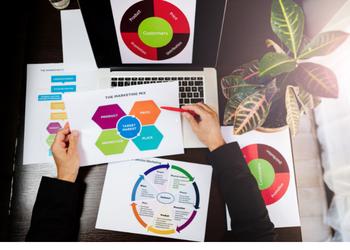Sharing Knowledge Keeps Associations Strong—Review Newest Survey Results and C-Suite Discussion

Early in my career, I was drawn to the nonprofit world. My attraction centered around the idea of sharing. Competition defines even the friendliest corporate relationships. Associations have a happier orientation to their community. We can learn and grow from each other’s experiences.
.orgCommunity exists to promote those opportunities. Our C-Suite Circles bring leaders together to celebrate success, lean on each other, and become their best professional selves.
Meetings are on every executive’s mind. People are wondering whether decisions they’ve made will be successful, how others are addressing challenges, and where there is room for innovation and experimentation. Our group wanted to explore that topic.
Prior to our conversation, we asked participants to complete a survey related to their experiences with events during the last year. The results aren’t surprising. But the dialogue around each topic adds important perspective. This post passes the survey results and the group’s ideas and insights along to you.
In-Person, Hybrid, or Virtual?
Were hybrid meetings part of your vocabulary before 2020? Surprisingly, while 70% of our survey respondents were holding in-person meetings; there were 30% who had already organized a hybrid or virtual event. In 2021, there was an even split between those who held virtual and hybrid meetings, with no fully in-person meetings scheduled. The pendulum swings the 70% majority to the hybrid column in 2022, while the other 30% are evenly divided between in-person, virtual, and those who were undecided about a venue.
An interesting fact that emerged during our discussion was that a hybrid meeting is a little like jazz. Everyone is playing their own interpretation. That definition is a work in progress that is being constantly modified based on experience.
My year included organizing two hybrid events for .orgCommunity. The Innovation Summit took place last July and on November 10, we hosted Solutions Day. Both meetings were successful, but they also involved more effort and resources than I imagined. We used an experienced AV crew as well as a state-of-the-art facility for the Innovation Summit. For Solutions Day, we did not have the same depth of AV expertise available.
My takeaway is that .orgCommunity will not live stream presentations again. We’ll probably record the sessions and host a virtual event several weeks after the live meeting. Others were adopting a similar strategy. Although there were some positive experiences with live streaming, most of the group agreed that the benefits were not worth the expense and effort involved.
In terms of timing, 29% of survey respondents produced shorter programs and 23% made no changes to their plans. The other 48% made a variety of adjustments to the number, duration, and scheduling of sessions or of the event.
Revenue

Revenue projections were a scary wildcard in 2020. Of survey respondents, 65% reported decreases. However, a fortunate 25% experienced an increase, while for the other 10% revenue remained stable. The survey did not reflect profitability.
Within the discussion group, some organizations increased revenue due to a decrease in the expenses for a virtual meeting. For others, COVID was a wake-up call to make much-needed improvements in their online offerings, resulting in greater participation. In the case of medical organizations, the pandemic provided new, more compelling reasons for member engagement.
The survey results related to sponsorship revenue closely paralleled member registration. A few lucky, or very smart, organizations saw revenue increases. The discussion group observed that what’s old is new again. Interest in sponsoring or exhibiting at newly scheduled in-person meetings has increased over previous years. One association reported doubling income.
There was universal agreement that the online exhibit hall is one party where the guests are never going to mingle. It’s easy for sponsors, situated at the perimeter of the event, to become virtual wallflowers. For some companies, lack of experience with designing digital space and offering enticing incentives proved to be a stumbling block. When sales representatives turned to their marketing teams for support, the results were better. Weaving sponsor messaging into the fabric of the meeting, via presentations or other types of thought leadership, also produced positive results.
Promotion

As you might expect, social media and email were star meeting promoters. Sixty-three percent of survey respondents expanded activities on social platforms, and approximately the same number increased email marketing. While 80% of respondents also reported using alternate promotional strategies.
Collaborating with social media influencers was one of the more creative examples of outreach we explored during our Circle conversations. One group identified the experts members were following on various platforms and provided them with meeting-related information to seed through their posts. The unique content attracted new visitors to the association’s website.
Customer service and marketing teams followed up on every lead. When they discovered a prospect who clicked through an email campaign message but did not register for the meeting, a personal call was made to offer assistance with decision-making.
Another group member took a counter-intuitive approach. Although print promotion was declining long before the pandemic, this association initiated a physical newsletter. The reasoning was: first, a similar publication didn’t exist, and second, the majority of members were over 50 years old. The piece, which was projected to be revenue-neutral, was quickly running in the black. Sponsors were also delighted to have a new advertising venue.
Word of mouth was another low-tech strategy that paid off for some. One association launched a series of webinars using board members to answer critical questions around COVID-related issues. The sessions’ popularity snowballed, eventually attracting over 500 participants.
It’s tempting to allow trends to override objectivity. But by resisting the urge to pigeonhole your audience, studying their habits and the data, and meeting unique needs, you can deliver positive results.
Networking
Survey respondents experimented with a variety of virtual networking options. Chatrooms, discussion boards, or virtual social hours were the most popular.
The discussion group labeled networking and virtual as oxymorons. Several leaders reported extensive planning for social activities, only to experience disappointing participation. Online networking seemed to be most successful with a limited number of people in defined groups. Activities such as one-on-one mentoring sessions received some traction. The take-away was that copycatting between worlds doesn’t work. Going digital demands a fresh, creative approach.
Diversity, Equity, and Inclusion
DEI issues did not get short shrift on virtual platforms. Over 50 percent of survey respondents increased diversity of their speakers and added content on DEI topics.
Discussion participants reported that DEI is a high priority within their organizations. There is a deliberate effort to include related topics or tracks in programming. The group also considered whether translation services are a valuable add-on for international meetings. The consensus was that the level of usage doesn’t justify the expense. However, strategies such as discussion tables, that make it possible for meeting attendees to dialogue about a presentation in their native language, generated some interest.
Lessons Learned
To conclude the conversation, we asked the group to summarize lessons learned over the past year. Following is their advice:
- Virtual networking is a challenge. We’re not there yet.
- Don’t rule anything out. Be creative. Test and experiment. There are strategies to succeed, even with limited resources. When you are honest with people they will be forgiving.
- Understand your audience and tailor activities to meet their needs.
- Rethink the sponsorship model to address new expectations.
- Planning a hybrid meeting is like planning two meetings.
- Members adjusted their expectations to the situation, but next year they will be more exacting.
My personal lesson learned is one I have known for a long time. Our ability to share knowledge in the face of challenges and benefit from each other’s experiences makes us strong. It is our best hedge against disruption and a reliable strategy for future success.
